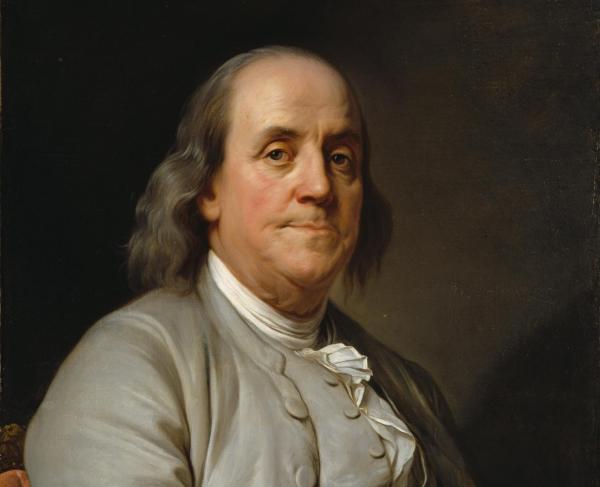Benjamin Franklin

Benjamin Franklin was born in Boston, Massachusetts on January 17, 1706. Growing up, Franklin came from a modest family and was one of seventeen children. He began his formal education at eight when his father enrolled him in the Boston Latin School. While in school, Franklin showed strong leadership skills and was an avid reader and writer. Since his family could only afford Franklin's education for two years, he dropped out and began working for his father at age ten. At 15, Franklin's older brother James accepted him as an apprentice at his print shop in Boston. Under James, Franklin began working for one of the first newspapers in America, The New England Courant. While working at the print shop, Franklin wrote under the pseudonym Silence Dogood. He became an advocate for free speech, despite his brother's wishes. At age 17, Franklin ran away from his family to Philadelphia. In doing so, he broke his apprenticeship, making him a fugitive. While in Philadelphia, Franklin found work as a printer and began making connections, including meeting his future wife, Deborah Reed. Franklin sailed to London, England, a year later and began working as a typesetter in a print shop. He returned in 1726 and opened his own print shop in Philadelphia, where he published a newspaper called the Pennsylvania Gazette and the "Poor Richard's Almanack."
While in Philadelphia, Franklin created the first volunteer firefighting company and became involved with public affairs. In 1743, he founded the American Philosophical Society and began researching electricity. During his lifetime, Franklin continued to study science, including oceanography, engineering, meteorology, and physics. While studying, he created experiments, including the kite experiment, and invent products like the lighting rod based on his research. In addition to science, Franklin was interested in education and caring for society. Due to his wealth, Franklin organized the Pennsylvania militia and founded the first hospital in the colonies. Under Franklin's influence, the city streets were clean, and colonists in Philadelphia had homeowners' insurance. Franklin's popularity grew when he aided in founding the Academy of Philadelphia, later known as the University of Pennsylvania.
Since the French and Indian War, Franklin supported the American cause. In 1754, during the Albany Congress, he used the press to circulate the famous "Join or Die" cartoon in an attempt for the colonies to rally against the French. While at the congress, Franklin proposed the Albany Plan, which failed then but later inspired the Articles of Confederation and a uniting of the colonies. As tensions rose in the colonies, the Franklin press continued to publish pro-independence articles and stories. In 1751, Franklin was elected to represent the Pennsylvania assembly in the British parliament in London. He made connections in England with parliament officials and worked to settle disputes between the colonies and Britain. Franklin temporarily returned home until he was sent back to London in 1765 to testify against the Stamp Act. During Franklin's second mission to England in 1775, the British fired upon colonists at Lexington and Concord, officially beginning the American Revolution.
Upon hearing the news, Franklin returned to the colonies. He arrived in Philadelphia in May of 1775, and the Pennsylvania Assembly elected Franklin to the Second Continental Congress. The congress met to discuss the revolution's goals and plan the next steps for the colonies. While serving as a delegate for Pennsylvania, Franklin served as the United States' first postmaster general, suffered from gout, and missed most of the delegations. In early 1776, he was elected to the "Committee of Five," alongside Thomas Jefferson, John Adams, Robert Livingston, and Rodger Sherman was assigned to write the Declaration of Independence. Although Thomas Jefferson wrote most of the declaration, Franklin made "small but important changes." On July 4, the Declaration of Independence was signed, and the colonies readied to take the next step toward independence. In October 1776, Franklin was assigned the duty of Ambassador to France. To beat the British, the colonist needed European aid, and it was Franklin's mission to convince France to help the United States.
While in France, Franklin made connections with French politicians and the monarchy. France was willing to aid the colonies but needed proof that the American Revolution was not a lost cause. In October 1777, the Continental Army won a significant victory over the British during the Battle of Saratoga, forcing a British army to surrender. The battle showed that the United States had the potential to win and the French to sign the 1778 Alliance Treaty, solidifying the Franco-American alliance. French troops arrived in the colonies under the command of Jean-Baptiste, Comte de Rochambeau. The Continental and the French army worked together and were victorious during the Battle of Yorktown. In 1783, Franklin aided in the surrender under the Treaty of Paris. He remained in France for another two years, continuing to serve as the American minister for France and Sweden, despite never visiting. In 1785, Franklin returned to the United States and was immediately assigned to represent Pennsylvania in the Constitutional Convention.
At age 81, Franklin was the oldest representative at the convention. As a supporter of the United States Constitution, Franklin urged his fellow delegates to support the document. The Constitution was ratified in 1788, and the following year George Washington was selected as the United States' first President. On April 17, 1790, Franklin died in his Philadelphia home. Over 20,000 people attended his funeral in Pennsylvania to celebrate his life, accomplishments, and impact on the founding of the United States.

